Click here to see the study sheet: UNIT 8. STUDY
In this unit we are going to study:
Present Perfect
In the following link you can find game, exercises and more information about present perfect
More information
We are going to review:
Irregular verbs
Superlative
Write an email:
PARTS:
1. Salutation/ greeting (It's like saying "Hi")
Hi John,
Hello Mary,
Dear,
2. body (This is where you write your message)
I'm writing to tell you about......
Last week/ last weekend....
I have been....
I have gone....
3. Closing
Cheers,
Bye,
Write soon,
4. Signature (your name)
How to write an email
Este blog pretende ser una herramienta más en el aprendizaje de inglés del colegio Pedro de Valencia de Zafra, para motivar a los alumn@s y compartir experiencias.
viernes, 24 de mayo de 2019
lunes, 29 de abril de 2019
5th grade: SOCIAL SCIENCE. Unit 8 THE TIME OF THE CATHOLIC KINGS
Catholic Monarchs, also called Catholic Kings, or Catholic Majesties, Spanish Reyes Católicos, Ferdinand II of Aragon and Isabella I of Castile, whose marriage (1469) led to the unification of Spain, of which they were the first monarchs.
Although employed earlier, the appellation Católicos was formally conferred on them in a bull published by Pope Alexander VI in 1494, in recognition of their reconquest of Granada from the Moors (1481–92), their New World discoveries (1492), and their strengthening of the church by such agencies as the Spanish Inquisition and such measures as compelling Jews to convert to Christianity or face exile (1492).
HISTORIA DE EXTREMADURA
Extremadura en la historia, ¿qué papel desempeñaron Francisco Pizarro, Hernán Cortés, Vasco Núñez de Balboa, Hernando de Soto, Francisco de Orellana, Pedro Alvarado y Contreras, Pedro de Valdivia, Inés de Suárez, Alonso de Mendoza...?
LOS REYES CATÓLICOS
CAME FROM AMERICA/VINO DE AMÉRICA
FROM EUROPE TO AMERCIA/DE EUROPA A AMÉRICA
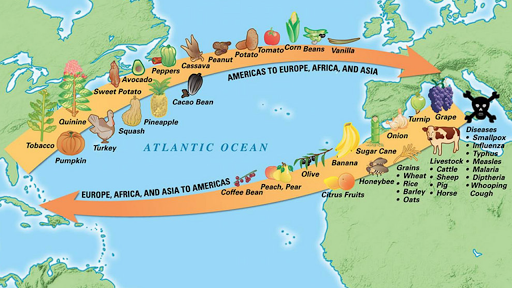
Contesta a estas preguntas:
¿Quién sucedió a los Reyes Católicos?
¿Qué relación tenía con los Reyes Católicos?
¿Quién era Felipe II?
V CENTENARIO DE LA PRIMERA VUELTA AL MUNDO
ARQUITECTURA: EL RENACIMIENTO
En esta unidad realizaremos un cómic, utilizando STORYBOARDTHAT
Although employed earlier, the appellation Católicos was formally conferred on them in a bull published by Pope Alexander VI in 1494, in recognition of their reconquest of Granada from the Moors (1481–92), their New World discoveries (1492), and their strengthening of the church by such agencies as the Spanish Inquisition and such measures as compelling Jews to convert to Christianity or face exile (1492).
HISTORIA DE EXTREMADURA
Extremadura en la historia, ¿qué papel desempeñaron Francisco Pizarro, Hernán Cortés, Vasco Núñez de Balboa, Hernando de Soto, Francisco de Orellana, Pedro Alvarado y Contreras, Pedro de Valdivia, Inés de Suárez, Alonso de Mendoza...?
LOS REYES CATÓLICOS
CAME FROM AMERICA/VINO DE AMÉRICA
FROM EUROPE TO AMERCIA/DE EUROPA A AMÉRICA

Contesta a estas preguntas:
¿Quién sucedió a los Reyes Católicos?
¿Qué relación tenía con los Reyes Católicos?
¿Quién era Felipe II?
V CENTENARIO DE LA PRIMERA VUELTA AL MUNDO
ARQUITECTURA: EL RENACIMIENTO
En esta unidad realizaremos un cómic, utilizando STORYBOARDTHAT
viernes, 26 de abril de 2019
3rd GRADE: NATURAL SCIENCES ORCHID
El próximo jueves 2 de mayo (siempre que el tiempo lo permita), haremos una salida al LIC Sierra de los Olivos.
GUÍA DE ORQUÍDEAS DE EXTREMADURA
En ese enlace podéis ver las diferentes orquídeas que hay en nuestra región.
Hay más de 25 mil especies de esta flor, nosotros vamos a intentar identificar algunas de ellas.
Tienen un sistema de reproducción llamativo para abejas y hongos
Por lo general, las orquídeas tienen tres sépalos, dos pétalos y un labelo que sirve para atraer a los polinizadores. Su forma permite que las abejas y los otros insectos puedan posarse cómodamente en él.
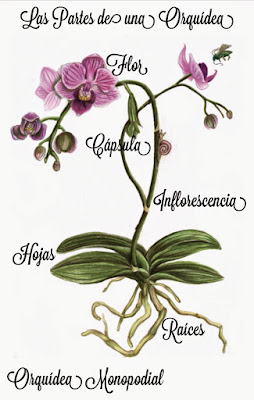
Estas son algunas de las especies que vamos a estudiar:


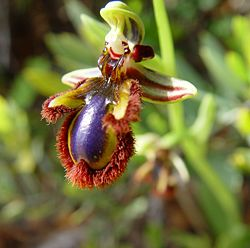
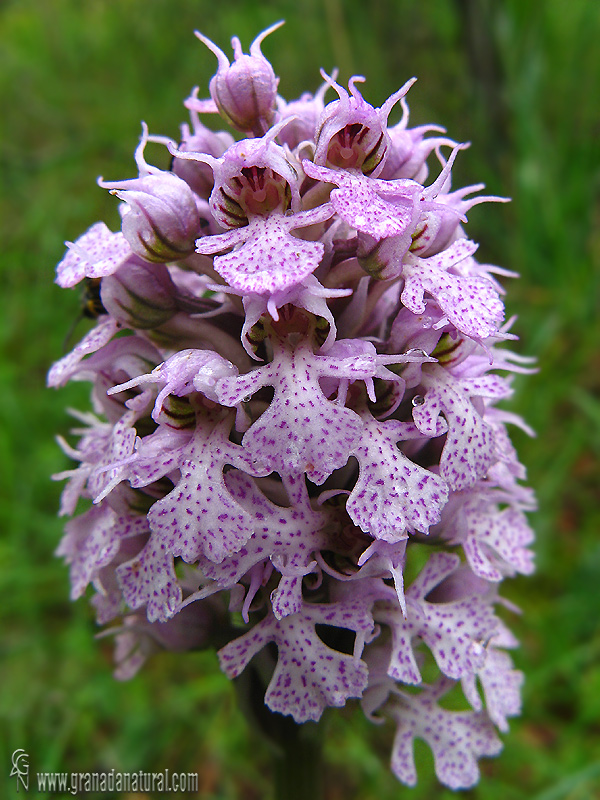
GUÍA DE ORQUÍDEAS DE EXTREMADURA
En ese enlace podéis ver las diferentes orquídeas que hay en nuestra región.
Hay más de 25 mil especies de esta flor, nosotros vamos a intentar identificar algunas de ellas.
Tienen un sistema de reproducción llamativo para abejas y hongos
Por lo general, las orquídeas tienen tres sépalos, dos pétalos y un labelo que sirve para atraer a los polinizadores. Su forma permite que las abejas y los otros insectos puedan posarse cómodamente en él.

Estas son algunas de las especies que vamos a estudiar:
OPHRYS LUTEA

OPHRYS INCUBACEA


OPHRYS SPECULUM
ORCHIS CÓNICA


ORCHIS ITÁLICA

ORCHIS PAPILONACEA

miércoles, 24 de abril de 2019
5th GRADE: ENGLISH. Unit 7. Writing a polite letter
HOW TO WRITE A POLITE LETTER:
We are going to write a polite letter to the company: Les vedettes de Paris.
We are going to imagine that we have done a Cruise on the Sena River with this company.https://www.vedettesdeparis.fr/produits/sightseeing-cruise/?lang=en§ion=croisieres
1st: RECIPIENT'S NAME
ADDRESS
TODAY'S DATE
2nd: SALUTATION
Dear Mr /Ms ....................
3rd: THE BODY
4th: COMPLIMENTARY CLOSE
Yours sincerely
Sign
Example:
Les Vedettes de Paris
Port de Suffren
75007
Paris
24th April 2019
Dear Mr Vandaele,
I did the guided tour aboard the Vedettes de Paris cruise ship on Thursday with my class. I am writing to thank you for inviting us. We had a great time. I really enjoyed looking at the Tour Eiffel, Orsay and Louvre Museum, Notre Dame de Paris, Obelisque de la Concorde,... My favourite building was Notre Dame cathedral. After our visit, we made a paper Paris city and display it on the corridor of our school.
I'd like to visit your city again one day.
Your sincerely,
Mary Irgin
martes, 23 de abril de 2019
5th grade: Social Sciences ARQUITECTURA ROMÁNICA Y GÓTICA
El románico en Extremadura

El arte gótico surge en Extremadura de forma tardía con respecto al norte peninsular. Las órdenes militares, principalmente las de Santiago y Alcántara, son las principales impulsoras de las construcciones góticas. La mayor representación gótica es la catedral. En Extremadura destacan la catedral nueva de Plasencia , la de Coria y la de Badajoz, así como la concatedral de Santa María de Cáceres. Otras importantes manifestaciones de la arquitectura gótica son algunos castillos y palacios, entre los que destacan los castillos de Granadilla, Alburquerque, Montánchez, Burguillos del Cerro, Puebla de Alcocer, Coria y Belvís de Monroy, el Alcázar de los Duques de Feria, en Zafra, o la Casa de los Solís y la Casa de los Becerra, en Cáceres. Son especialmente relevantes algunas portadas góticas, como las de las iglesias de Villafranca de los Barros, Fuente del Maestre, Azuaga y Arroyo de la Luz.El monasterio de Yuste cuenta con un magnífico claustro gótico. Así mismo, el monasterio de Guadalupe conserva excelentes obras góticas, como la iglesia del Real Monasterio, las puertas de bronce y algunos sepulcros, como el del padre Gonzalo de Illescas.En Trujillo se encuentra el mejor retablo gótico de Extremadura, el de la iglesia de Santa María.En definitiva, todos estos ejemplos revelan que el gótico, en sus diversas tendencias, es el estilo artístico predominante en Extremadura.
Catedral de Cáceres
Catedral Vieja y Nueva de Plasencia
Catedral de Coria
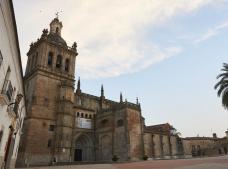
Tras la batalla del Salado, Alfonso XI ordena la construcción de una fortaleza con una iglesia adosada. La iglesia debió construirse a finales del siglo XIV y debió estar terminada en los primeros años del siglo XV. Cuando Los jerónimos se hace cargo del monasterio en 1389 comienzan importantes obras de reforma como la fastuosa fachada meridional que sirve de entrada al templo, la construcción del claustro mudéjar incluyendo su célebre templete.
El Monasterio de Guadalupe

Más que románico, habría que hablar de tardorrománico puesto que la presencia musulmana se prolongó en Extremadura hasta mediados del siglo XIII, época en la que el arte gótico ya estaba consolidado en la mitad norte de la Península. Por tanto hay pocos ejemplos de arquitectura románica, fundamentalmente en la mitad norte de Extremadura.
http://www.viajarporextremadura.com/cubic/ap/cubic.php/doc/El-romanico-en-Extremadura-331.htm
Basílica de Santa Eulalia (Mérida)
http://www.viajarporextremadura.com/cubic/ap/cubic.php/doc/El-romanico-en-Extremadura-331.htm
Basílica de Santa Eulalia (Mérida)
El gótico en Extremadura
El arte gótico surge en Extremadura de forma tardía con respecto al norte peninsular. Las órdenes militares, principalmente las de Santiago y Alcántara, son las principales impulsoras de las construcciones góticas. La mayor representación gótica es la catedral. En Extremadura destacan la catedral nueva de Plasencia , la de Coria y la de Badajoz, así como la concatedral de Santa María de Cáceres. Otras importantes manifestaciones de la arquitectura gótica son algunos castillos y palacios, entre los que destacan los castillos de Granadilla, Alburquerque, Montánchez, Burguillos del Cerro, Puebla de Alcocer, Coria y Belvís de Monroy, el Alcázar de los Duques de Feria, en Zafra, o la Casa de los Solís y la Casa de los Becerra, en Cáceres. Son especialmente relevantes algunas portadas góticas, como las de las iglesias de Villafranca de los Barros, Fuente del Maestre, Azuaga y Arroyo de la Luz.El monasterio de Yuste cuenta con un magnífico claustro gótico. Así mismo, el monasterio de Guadalupe conserva excelentes obras góticas, como la iglesia del Real Monasterio, las puertas de bronce y algunos sepulcros, como el del padre Gonzalo de Illescas.En Trujillo se encuentra el mejor retablo gótico de Extremadura, el de la iglesia de Santa María.En definitiva, todos estos ejemplos revelan que el gótico, en sus diversas tendencias, es el estilo artístico predominante en Extremadura.
Catedral de Cáceres
Catedral Vieja y Nueva de Plasencia
Catedral de Coria

Tras la batalla del Salado, Alfonso XI ordena la construcción de una fortaleza con una iglesia adosada. La iglesia debió construirse a finales del siglo XIV y debió estar terminada en los primeros años del siglo XV. Cuando Los jerónimos se hace cargo del monasterio en 1389 comienzan importantes obras de reforma como la fastuosa fachada meridional que sirve de entrada al templo, la construcción del claustro mudéjar incluyendo su célebre templete.
El mudéjar en Extremadura
El Monasterio de Guadalupe
El Monasterio de Guadalupe es una de las obras cumbres del gótico mudéjar no sólo en Extremadura sino de toda España.

La citada fachada tiene puertas de arcos apuntados superados por tímpanos, marcos rectangulares y un gran rosetón, todo con tracerías flamígeras muy mudejarizadas.
El claustro es de espectaculares dimensiones y formado por un cuadrilátero de tramos formados por dos pisos formados por arcos apuntados de herradura sobre pilares ochavados.
En el centro se erigió un originalísimo templete en el cual se funde armoniosamente las formas góticas e islámicas formando una especie de pirámide de gabletes de exquisito aspecto.
5th grade: SOCIAL SCIENCES:MEDIEVAL TIMES (ROMANESQUE VS GOTHIC STYLE)
The Middle Ages, or Medieval Times, in Europe was a long period of history from 500 AD to 1500 AD. That's 1000 years! It covers the time from the fall of the Roman Empire to the rise of the Ottoman Empire.
This was a time of castles and peasants, guilds and monasteries, cathedrals and crusades. Great leaders such as Joan of Arc and Charlemagne were part of the Middle Ages as well as major events such as the Black Plague and the rise of Islam.
The Romanesque style refers to the types of cathedrals, monasteries, and places of religion built during the 1000s-1100s in Europe, and it gets its name from looking very Roman in appearance. In other words, columns and arches were frequently used, just like in ancient Roman architecture. Gothic buildings, on the other hand, came later. These were popular just after the Romanesque style began to lose its appeal, and were very fancy in comparison.
Cathedrals in the Gothic style were often narrow inside, filled with stained glass windows, and frequently had what were known as “flying buttresses” or large, curved stone arches connected to the outside of the building to give it support. This style became very popular for cathedrals throughout Europe, such as Reims Cathedral in France and Westminster Abbey in England. Many of these cathedrals have been well taken care of, and you can still visit them today.
NOTRE DAME DE PARIS
https://www.youtube.com/watch?v=DTHApIO_gW0
https://www.youtube.com/watch?v=zSQNQpWiMg4
https://www.youtube.com/watch?v=41fVMmo2FKk
https://www.youtube.com/watch?v=MihQQTi8ZrE
jueves, 11 de abril de 2019
domingo, 17 de marzo de 2019
Teatro jueves 28 de marzo: NAUTILUS
El próximo jueves 28 de marzo a las 12:30 iremos al IES Suarez Figueroa a ver la obra de teatro : NAUTILUS de la compañía de teatro Forum Teatro y Educación.
NAUTILUS
Los McFishers (Phineas, Mr Boat y Philomena, Mrs Ship) tienen una pescadería en el centro de Londres. Son coleccionistas de peces de todo el mundo.
Reciben la noticia de que en el Lost Sea se ha encontrado una extraña clase de pez: the gold fish....
NAUTILUS
Los McFishers (Phineas, Mr Boat y Philomena, Mrs Ship) tienen una pescadería en el centro de Londres. Son coleccionistas de peces de todo el mundo.
Reciben la noticia de que en el Lost Sea se ha encontrado una extraña clase de pez: the gold fish....
martes, 12 de marzo de 2019
5th grade: ENGLISH UNIT 6: SENSES
PLAN A PARTY
Where are we going to have the party?
We are going to have the party at my house/in the park / in the country
When are we going to have the party?
We are going to have the party tomorrow/ on Saturday/ next weekend
How many people are we going to invite to the party?
We are going to invite the whole class/ 20 people
What time is the party going to start?
The party is going to start at five o'clock/ at a quarter to six/ at half past five
What time is the party going to finish?
The party is going to finish at eight o'clock/ at quarter past eight
What are we going to eat at the party?
We are going to eat pizza, hot dogs, sandwiches, hamburgers, chips, cake, sweets...
We are going to have a barbecue
What are we going to drink at the party?
We are going to drink water, lemonade, juice, fizzy drinks, hot chocolate, strawberry/ chocolate/ vanille milkshake
What are we going to need for the party?
We are going to need costumes/ swimsuits/ sport clothes
lunes, 11 de marzo de 2019
5th grade: UNIT 6 SOCIAL SCIENCES. AL ANDALUS
We are going to learn about the period between 711 to 1492.
We are going to make a comic using this resource:
Also we are going to investigate about the legacy from this period
INFLUENCIA DEL ÁRABE EN EL ESPAÑOL: arabismos
We are going to make a comic using this resource:
INFLUENCIA DEL ÁRABE EN EL ESPAÑOL: arabismos
jueves, 21 de febrero de 2019
6th GRADE ENGLISH: A RECIPE FROM EXTREMADURA
Como el próximo lunes celebramos el día de Extremadura en la escuela y la semana cultural, uno de los projects del tema que estamos estudiando sería redactar una receta típica de la región en inglés.
Tiene que contener:
- INGREDIENTS.
-INSTRUCTIONS.
- A PHOTO OR PICTURE
- EXTREMADURA FLAG
Useful linking words:
Fist, second, third, fourth,...then, after, after that,... finally.
Useful verbs:
Put: poner
boil: hervir
cook: cocinar
add: añadir
chop: cortar
mix: mezclar
EXAMPLE.

Tiene que contener:
- INGREDIENTS.
-INSTRUCTIONS.
- A PHOTO OR PICTURE
- EXTREMADURA FLAG
Useful linking words:
Fist, second, third, fourth,...then, after, after that,... finally.
Useful verbs:
Put: poner
boil: hervir
cook: cocinar
add: añadir
chop: cortar
mix: mezclar
EXAMPLE.

miércoles, 20 de febrero de 2019
6th GRADE: SPANISH CIVIL WAR TOLD BY US
Esta semana estamos trabajando sobre la Guerra Civil española y para ello vamos a explicar que pasó haciendo algo similar a lo que se presenta en este vídeo pero en inglés:
martes, 19 de febrero de 2019
6th GRADE ARTS: KEITH HARING
U na vez finalizado el estudio de la obra de Picasso pasaremos a estudiar otro autor muy divertido puesto que emplea numerosos colores en sus obras. Se trata de Keith Haring.
keith haring presentation
keith haring presentation
lunes, 18 de febrero de 2019
5TH GRADE: SOCIAL SCIENCES. Al Andalus
We have started a new topic: Al Andalus.
You can watch these videos to have more information about this interesting period
LA EDAD MEDIA
You can watch these videos to have more information about this interesting period
LA EDAD MEDIA
domingo, 10 de febrero de 2019
5th GRADE: UNIT 5
We are going to write a text about different places from Zafra.
You can download a template from the following link:
DUKE OF FERIA PALACE
This is an Erasmus activity
5 PLACES TO VISIT IN ZAFRA
You can download a template from the following link:
DUKE OF FERIA PALACE
This is an Erasmus activity
5 PLACES TO VISIT IN ZAFRA
viernes, 8 de febrero de 2019
5th GRADE ARTS PICASSO. ERASMUS
Now, we are going to start a new project about Picasso
PICASSO AT WORK
You have to write a biography about this great author.
miércoles, 6 de febrero de 2019
jueves, 31 de enero de 2019
jueves, 24 de enero de 2019
6TH GRADE: PROJECT 2 TOPIC 3: WRITE A BIOGRAPHY OF A FAMOUS PERSON
El segundo project del tema 3 consiste en describir a un personaje histórico como por ejemplo a Leonardo Da Vinci:


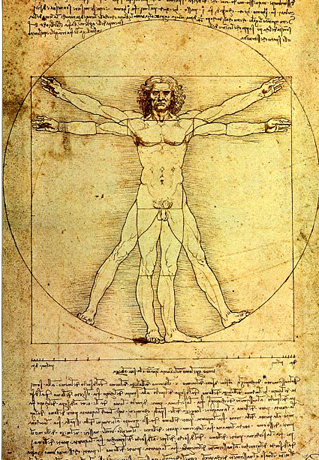
Leonardo da Vinci was born in the town of Vinci, Italy on April 15, 1452.
He lived during the Renaissance
He died on May 2, 1519. He was Italian.
Leonardo da Vinci was an artist, scientist, and inventor.
He painted the Mona Lisa, the Vitruvian Man and the Last Supper.
Flight was of particular interest to da Vinci. He studied the flight of birds and created plans for flying machines that resemble hang gliders and helicopters
The Vitruvian Man is a drawing by Leonardo da Vinci that describes the relationship between human proportions and geometry.
Da Vinci wrote in the opposite direction to what is normal, meaning you’d need a mirror to read it properly
USEFUL VERBS
Born- she/he was born
live- she/he lived
be- she/he was
study- she /he studied
start-she/he started
die- she/he died
paint-she/he painted
write-she/he wrote
become- she/he became
work-she/he worked
win- she/he won
USEFUL EXPRESSIONS
in ------ (place, year)
I think ------
In my opinion, -----------
|
6TH GRADE: PROJECT TOPIC 3: A LETTER TO A CAMPSITE
El proyecto del tema 3 consiste en escribir una carta a un campamento. (Activity book page 24) Para ello tienen que seguir las siguientes pautas:
- Dirección tuya a la derecha y fecha.
- Dirección del sitio al que dirigimos la carta a la izquierda.
- Saludo formal: DEAR SIR OR MADAM.
- Comenzamos explicando para que escribimos: I SAW YOUR WEBSITE/ ADVERTISEMENT/ LEAFLET,... AND I AM WRITING TO GET SOME INFORMATION ABOUT.....
- Frases educadas para preguntar: I WOULD LIKE TO ....( I would like to know if..../ when...../ how...)
- PLEASE, COULD YOU TELL ME...
- Despedida formal: YOURS FAITHFULLY
- Tu nombre y firma al final.
(Nombre y dirección del camping ) ( Tu dirección y fecha)
Dear Sir o Madam,
I saw your website on the Internet and I am writing to get some information about your campsite.
I would like to go with five friends in July, for 5 days, from Friday to Tuesday.
Please, could you tell me the best date to go?
We also want to know the price and if there are sport lessons. We love sports and we would like to play tennis , paddle or football.
We also saw that you have a great swimming pool. Please. could you send me your timetable?.
Yours faithfully
Jesús Pérez
- Dirección tuya a la derecha y fecha.
- Dirección del sitio al que dirigimos la carta a la izquierda.
- Saludo formal: DEAR SIR OR MADAM.
- Comenzamos explicando para que escribimos: I SAW YOUR WEBSITE/ ADVERTISEMENT/ LEAFLET,... AND I AM WRITING TO GET SOME INFORMATION ABOUT.....
- Frases educadas para preguntar: I WOULD LIKE TO ....( I would like to know if..../ when...../ how...)
- PLEASE, COULD YOU TELL ME...
- Despedida formal: YOURS FAITHFULLY
- Tu nombre y firma al final.
(Nombre y dirección del camping ) ( Tu dirección y fecha)
Dear Sir o Madam,
I saw your website on the Internet and I am writing to get some information about your campsite.
I would like to go with five friends in July, for 5 days, from Friday to Tuesday.
Please, could you tell me the best date to go?
We also want to know the price and if there are sport lessons. We love sports and we would like to play tennis , paddle or football.
We also saw that you have a great swimming pool. Please. could you send me your timetable?.
Yours faithfully
Jesús Pérez
miércoles, 23 de enero de 2019
5TH GRADE: Write/tell a story (Flyers Cambridge)
We are going to write a story.
Look at these pictures and write a story:
REMEMBER
1.- Title
2.- Characters (The people in the story)
3.- Setting (the place where the story happens)
4.- Time frame (when the story happens)
5.- Plot (what happens in the story)
A good story usually has names, places and other information.
You have to use:
linking words:
and, but, when, so, because
sequencing words:
then, first, finally, after that
Look at these pictures and write a story:
REMEMBER
1.- Title
2.- Characters (The people in the story)
3.- Setting (the place where the story happens)
4.- Time frame (when the story happens)
5.- Plot (what happens in the story)
A good story usually has names, places and other information.
You have to use:
linking words:
and, but, when, so, because
sequencing words:
then, first, finally, after that
STORY 1
STORY 2
After that, we are going to tell the story of LITTLE RED RIDING HOOD
STORY 3
- TITLE: The great idea!
- CHARACTERS: a boy- Jimmy. A man - his father
- TIME FRAME: A winter morning. Last December
- THE SETTING: A small cottage in the mountains
- THE PLOT: The car was covered in snow. They couldn't use the car. He went to school skiing
martes, 15 de enero de 2019
5th Grade: SOCIAL SCIENCES.UNIT 5.
En esta unidad vamos a hacer presentaciones utilizando nuestras cuentas de correo.
Bloque 1: Utilización de las TIC
Bloque 3: Vivir en sociedad
Contenidos: La constitución de 1978
Forma de gobierno, división de poderes
Organización territorial
Unión Europea
Utilizar las TIC para presentar un trabajo sobre la unidad 5
Se realizará una presentación de entre 5 y 10 diapositivas.
Será necesario incluir imágenes, textos y vídeos.
Se evaluará la selección de contenidos y la claridad de la exposición en clase ante el grupo
Bloque 1: Utilización de las TIC
Bloque 3: Vivir en sociedad
Contenidos: La constitución de 1978
Forma de gobierno, división de poderes
Organización territorial
Unión Europea
Utilizar las TIC para presentar un trabajo sobre la unidad 5
Se realizará una presentación de entre 5 y 10 diapositivas.
Será necesario incluir imágenes, textos y vídeos.
Se evaluará la selección de contenidos y la claridad de la exposición en clase ante el grupo
3rd grade: ARTS
Happy new year.
Vamos a empezar un trimestre nuevo con proyectos muy divertidos.
We are going to draw KEITH HARING:
We are going to draw KEITH HARING:
- dog
- flying saucers
- radiating baby
- dancing people
- pyramid
Suscribirse a:
Comentarios (Atom)










